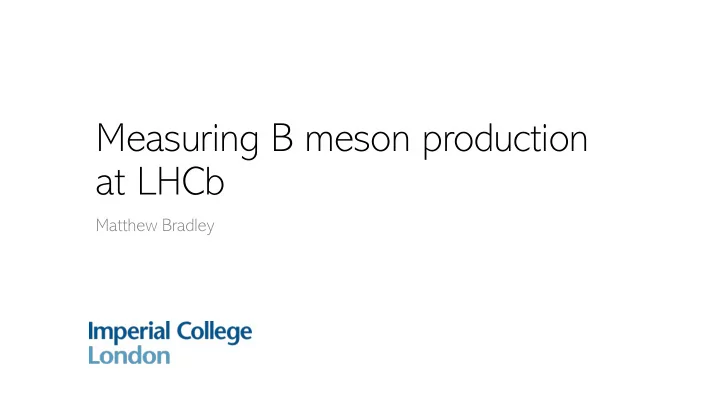

Measuring B meson production at LHCb Matthew Bradley
Introduction Contents of talk today: • Brief overview of the LHCb experiment • The current problem with combinatorial backgrounds • Aims of the project • Conclusion 1/10
2/10
LHCb Experiment • Dedicated to the study of heavy flavour physics • Aims to make precision measurements of CP violating processes and rare decays involving c and b quarks • Single arm forward spectrometer • Excellent PID and vertexing capabilities 3/10
The problem: combinatorial backgrounds • Currently remove these by requiring little activity in a cone around the candidate event • Definition of activity can vary (energy, number of objects considered etc.) • Challenging combinatorial backgrounds when two B hadrons decay with their decay products overlapping in detector • In this case would expect it difficult to isolate signal using above method, but we're not using all the available information – can we be smarter? 4/10
Initial Testing: MC of B meson production Difference in azimuthal angle Difference in pseudorapidity Δ Δ 902,371 events selected 5/10
Initial Testing: MC of B meson production • Angle between two B mesons Difference in angle between momentum vectors tends to be small • In some cases difficult to separate tracks from one another using angular variables alone • About 10% of the time the B mesons are in the same jet • Using more information about tracks may help in these cases Δ 902,371 events selected 6/10
Additional information to remove backgrounds • Look at tracks our candidate event has and see how many good vertices each has • The larger the number of vertices the greater the chance the candidate event is a background rather than signal • This requires good vertexing capabilities and spatial resolution in the detector - which LHCb has! 7/10
Initial Testing: MC of B meson production Separation of B meson vertices • Spatial resolution in LHCb better than 0.1mm • This spatial resolution is crucial as can, for example, separate out well the production vertices of two B mesons • Will require that we can spatially isolate potentially good vertices of tracks from backgrounds 8/10
Plans for the project • Need to investigate whether we can identify backgrounds based on spatial isolation and number of potential vertices for each track • Could use several different track variables to help us do this • May use machine learning to identify most important features / check how useful our approach is • Hope that this will allow for a better yield in analyses at LHCb 9/10
Conclusions • Current strategy for removing combinatorial backgrounds based on angular variables alone may not be the most effective • Can be difficult to remove large amounts of backgrounds whilst keeping yield high • Aim to introduce a new strategy based on spatial isolation and vertices of tracks to identify potential backgrounds • Will develop and test this idea over the coming months 10/10
Thank you for listening!
b quarks produced in same direction
Good PID, example from RICH
Recommend
More recommend